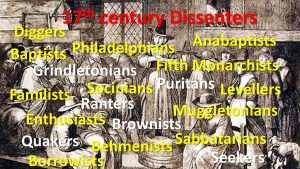Early Faith in the Dales
Menu
The Parishes of Upper Wensleydale
Monastic times
Shortly after the Norman conquest in 1066 and the Harrying of the north in 1069 which was designed to stop uprisings and rebellion, one of the largest feudal holdings in England was establish under Count Alan of Britany in 1071. It included Wensleydale, Swaledale and part of Teesdale. His brother Ribald built the Motte and Bailey castle in Middleham, just SW of the later stone castle built in the mid 12th Century. Richmond Castle was built in 1271 though there had been a stone keep since 1088.
Large areas of the dale came under Monastic control on land that was initially endowed from Norman landlords in exchange for prayer for their families. Often a lot of land was later purchased by the monastic orders.
In 1145 the first Abbey was established in upper Wensleydale at Fors on a site by the present day Grange Farm a mile west of Askrigg (Grid Ref SD93532 90931). There is virtually no evidence left for this building apart from what is found in documentation, graves discovered when the railway was built, and one stone window frame reused in one of the farm buildings. It is thought that John Colby used some of the stone to build nearby Coleby Hall in 1633, and there is disputed evidence that pillars in the north aisle at St Oswalds church in Askrigg was built of stone from the ruins of Fors Abbey. There is plenty map evidence in the local names including: Abbottside, Abbey Head, Grange beck and Grange farm.
Fors Abbey was managed by Peter de Quincy – a monk from the Abbey of Savigny in Brittany. This was originally a Benedictine order. Land was acquired with rights to mow grass in the forest, fell timber, work for lead and iron and to collect killed deer.
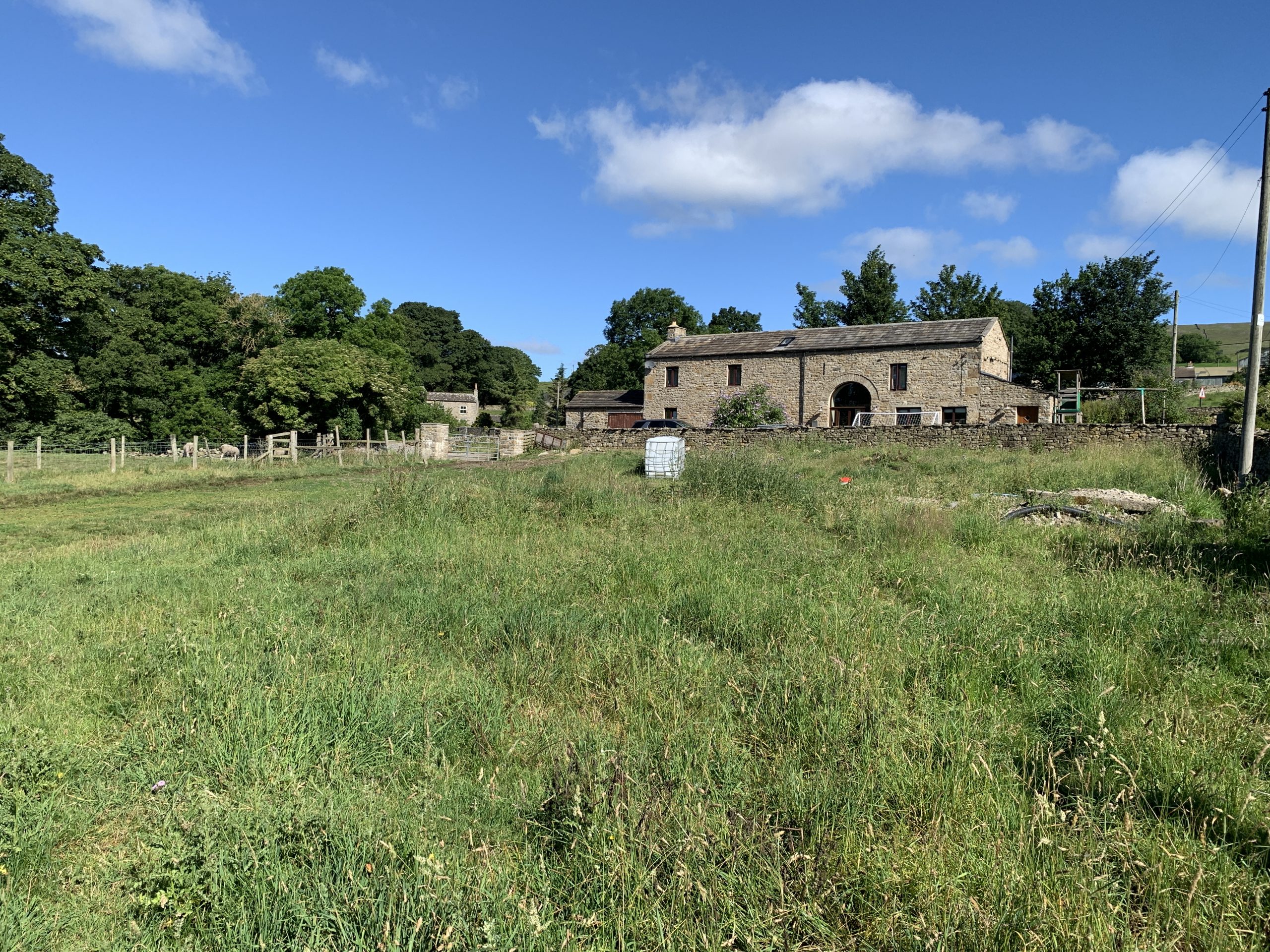
After five year the Abbot of Savigny was unhappy about the isolated location and withdrew his support. At the same time the Benedictine order in France was having financial difficulties and it merged with the Cisterians. Fors was but under the control of Byland Abbey and the abbot appointed a new lead monk. Following several years of poor harvests, the barrenness of the soil and the inclemency of the climate, Fors Abbey was abandoned after only 11 years. It became a Grange (farm) for the new abbey built further down the dale.
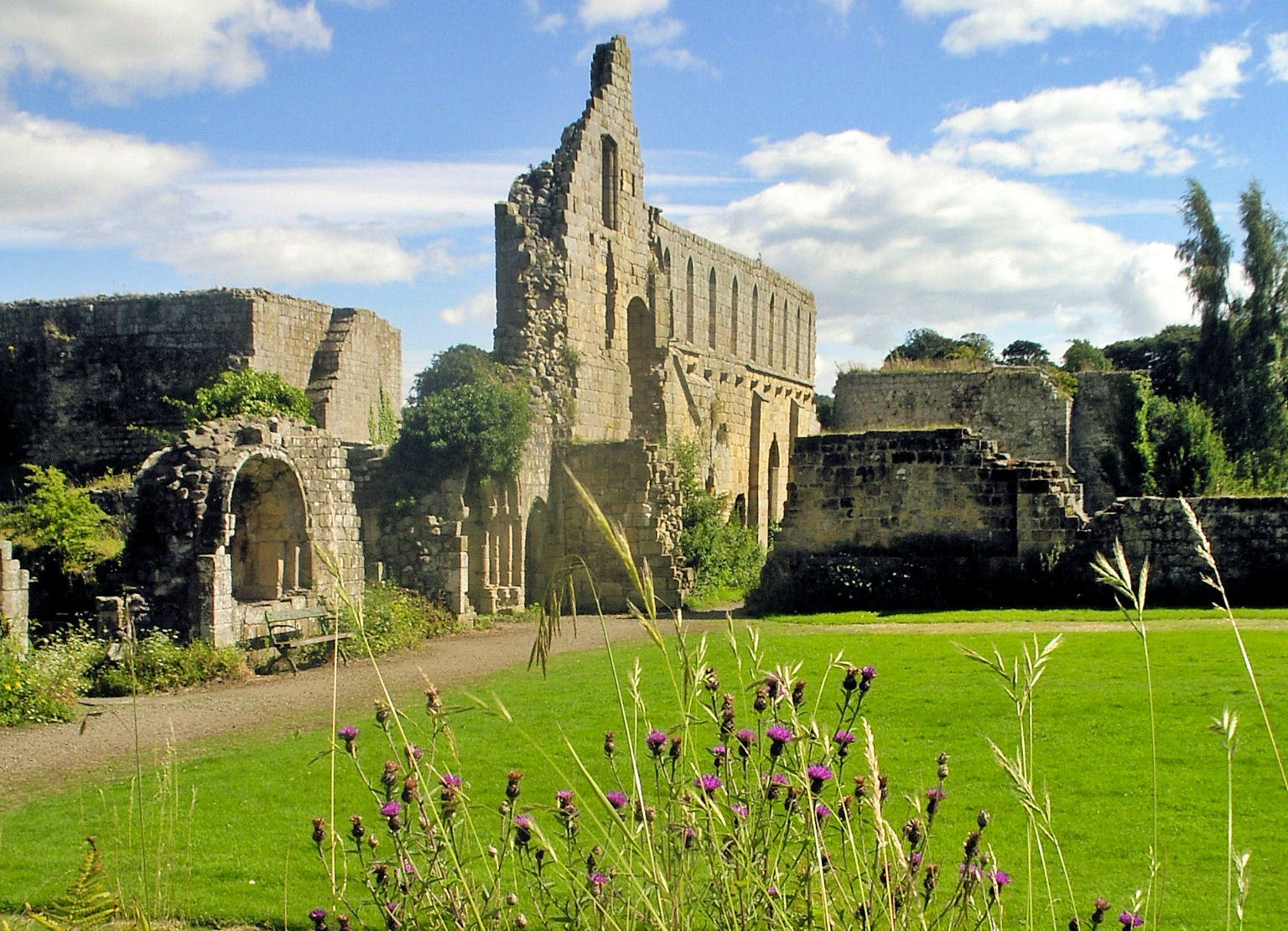
Jervaulx Abbey (named after the river Yore / Jor – vall) was established in 1156 on land given at a site below East Witton. It was a Cistercian monastery dedicated to the Virgin Mary. It was never very large. By 1380 there were only 16 monks and by 1537 only 25. They owned and worked several granges nearby at Kilgram, Newstaed, Braithwaite, Akebar and further away at Dale Grange – their original site and at Fossdale and Melsonby. By the time of the dissolution of the Monasteries by Henry VIII between 1536 – 40, the abbey’s Manor extended westwards to include all the land north of the River Ure to the watershed with Swaledale and to the source at Hell Beck.
The last Abbot of Jervaulx (the 23rd) – Abbot Adam Sedbar was hung at Tyburn in 1537 because of his involvement in the Pilgrimage of Grace (an attempt to reverse the reformation).
The Pilgimage of Grace started in the Lincolnshire Uprising in Louth led by Robert Ask of Ask Hall in Richmondshire. In 1536 draft petitions were formulated to the King at Pontefract Castle. The foundations were 3 fold:
Economic – The poor harvest of 1535 had led to high food prices and the dissolution of the monasteries had led to loss of work and shelter.
Political – there was general objections to Henry’s treatment of his wives and the aristocrats objected to Thomas Cromwell because of his low estate
Religious – the local church communities were worried about confiscation of the church plate, taxing of baptisms and the ten article – the new order of prayer.
The rebellion failed and 216 people were hung including 7 Abbots*, 38 monks and 16 parish priests.
The buildings at Jervaulx were destroyed by 1539
*Adam Sedbar, Abbot of Jervaulx, William Trafford, Abbot of Sawley, John Paslew, Abbot of Whalley, Matthew Mackarel, Abbot of Barlings and Bishop of Chalcedon, William Thirsk, Abbot of Fountains and the Prior of Bridlington.
The Knights Templars
The Knights Templars were a minor monastic order that evolved to protect pilgrims travelling to and from Jerusalem. Founded in 1119 the order grew rapidly in membership and power. They were a skilled fighting unit during the crusades and became very rich very quickly.
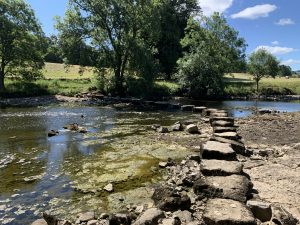 In Wensleydale they are thought to have had an early dwelling at Slaphow near the river at Slapestone Wath (meaning slippery stones crossing). (Grid Ref SE 03145 89612). This preceptory built to north west of Temple farm is first mentioned between 1170 and 1181. There is little physical evidence of the use of this site but it is a prominent river crossing from the north of the river (and later from Castle Bolton) to the entrance to Bishopdale.
In Wensleydale they are thought to have had an early dwelling at Slaphow near the river at Slapestone Wath (meaning slippery stones crossing). (Grid Ref SE 03145 89612). This preceptory built to north west of Temple farm is first mentioned between 1170 and 1181. There is little physical evidence of the use of this site but it is a prominent river crossing from the north of the river (and later from Castle Bolton) to the entrance to Bishopdale.
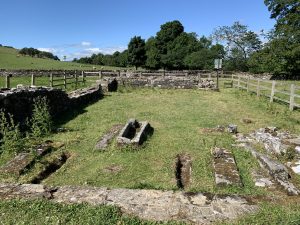 By 1202 they had moved to the hillside south of Temple Farm. (Grid Ref SE 03593 88740) The chapel there was dedicated to ‘God, the Virgin Mary and St Catherine.’ St Catherine, the patron saint of linen weavers, was important to the Templars because their outer garments were made of white linen on which was sewn a blood red cross, their symbol of martyrdom.
By 1202 they had moved to the hillside south of Temple Farm. (Grid Ref SE 03593 88740) The chapel there was dedicated to ‘God, the Virgin Mary and St Catherine.’ St Catherine, the patron saint of linen weavers, was important to the Templars because their outer garments were made of white linen on which was sewn a blood red cross, their symbol of martyrdom.
The Order was suppressed in 1307 – Rumour about a secret initiation ceremony created distrust and King Philip lV France pressurized Pope Clement to have them arrested and eventually disbanded
In Wensleydale the charges against the brotherhood were particularly severe. Many of the Templars were imprisoned and some were tortured and executed. The master of the House on Penhill, Thomas de Bellerby, was one of a score of Knights apprehended and locked up in York Castle in the autumn of 1309. He, like others, was tortured and killed and the House and the chapel, together with 80 acres of surrounding land and buildings, were taken over by King Edward II.
Pope Clement V abolished the order in 1312 and the Penhill site was handed over to the Knights Hospitallers. It was not used much and by 1328 was abandoned.
A site at Palmer Flatts near Aysgarth Falls (Grid Ref SE 01121 88345) is thought to have been a site of a medieval Hospice for returning pilgrims and run by the Knight’s Templars. (Pilgrims returning from the Holy Land in poor health carried ‘Palms’ – hence the name)
The Parishes of Upper Wensleydale
The ecclesiastical parish system started with the introduction of Christianity around the 6th century and they were fully developed between the 10th and 14th centuries. Aysgarth Parish covered most of Wensleydale, Bishopdale and the smaller side dales. St Andrews church 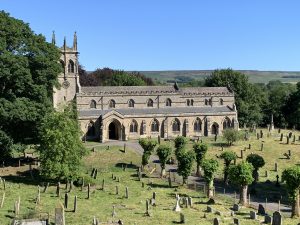 was the main place of worship from 10th century. It would have linked to Jervaulx as the Patron of the parish. A 10th Century cross was discovered in a nearby stone wall. It may have been a preaching cross or it might have stood outside a Saxon Church. A church certainly existed in 12th century when it was described as the ‘mother church’ for a chapel of ease at Askrigg. The first recorded rector of Aysgarth was Peter de Thoresby, appointed in 1236.
was the main place of worship from 10th century. It would have linked to Jervaulx as the Patron of the parish. A 10th Century cross was discovered in a nearby stone wall. It may have been a preaching cross or it might have stood outside a Saxon Church. A church certainly existed in 12th century when it was described as the ‘mother church’ for a chapel of ease at Askrigg. The first recorded rector of Aysgarth was Peter de Thoresby, appointed in 1236.
The Norman church was rebuilt in 1536 (as monasteries were dissolved) but by the Victorian period it was in a poor state. It had to be completely restored in 1866, giving it a decidedly Gothic revival air. Despite the sweeping Victorian changes the church retains some remarkable historical features. Woodwork and inscriptions indicate links to Jervaulx. (The rood screen may have come from Jervaulx / or [because it is not typical of that found in the monasteries] made and given by the monks at Jervaulx –Ella Pontefract and Hartley)
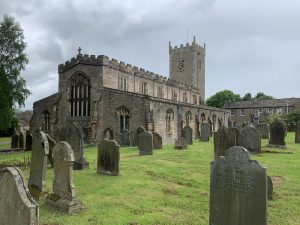 There has been a church on the site of St Oswalds in Askrigg since at least 1180. That first building was a chapel of ease under Aysgarth. Local tradition says that there was a preaching cross at Kirk Close, on the eastern fringe of Askrigg, and there may have been a Saxon church close by. The present church dates from 1466. For centuries people in Hawes and the upper dale would be travelling to Aysgarth or Askrigg for services, baptisms, marriages and funerals.
There has been a church on the site of St Oswalds in Askrigg since at least 1180. That first building was a chapel of ease under Aysgarth. Local tradition says that there was a preaching cross at Kirk Close, on the eastern fringe of Askrigg, and there may have been a Saxon church close by. The present church dates from 1466. For centuries people in Hawes and the upper dale would be travelling to Aysgarth or Askrigg for services, baptisms, marriages and funerals.
It was not until the end of the 16th and beginning 17th centuries that chapels of ease were built in Hardraw, Hawes, Stalling Busk and Lunds. Initially these were still in the parish of Aysgarth and with pastoral links to Askrigg.
By now The Church of England was established with Henry VIII’s separation from Rome in the mid 16th C and the associated dissolution of the monasteries.
Hardraw church was built in the early 16th Century and saw its first curacy in 1686. It was rebuilt in 1880 by Earl of Wharncliffe in memory of his brother (see the plaque inside the church). He lived at Wortley Hall in S Yorkshire but had a shooting lodge at Simonstone.
Hawes old chapel building in the lower part of the present graveyard was probably existing from 1620, (it was extended in 1712) However with an increase in the population in the upper dale Hawes began to agitate for parish independence. A refusal to pay the Hawes quarter led to dispute resolution being sought in the ecclesiastical courts in Richmond and York, followed by the common law court in York. The earliest records that survive containing baptisms, weddings and funerals in Hawes date from 1695.
Lunds had a curate appointed 1713 (the church was probably built earlier in the century). A preaching cross and possibly services were held prior to that on Course Haw (cowshaw) hill nearby. Lunds church merged with Hardraw 1858
The original church for Stalling Busk (by the lake side) was built in 1603 but fell into ruins during civil war 1642 – 51. It was rebuilt by villagers in 1722 and a curate appointed. Disputes with Aysgarth over baptisms and marriages resulted in it becoming a perpetual curacy in 1750’s and an independent parish by 1860’s
Non – Conformists in the Dale
Though in the 16th Century the Church of England had become the established church in England, there were those who didn’t conform. This included the Catholics who in many areas were driven underground seeing some revival with initial changes in the monarchy. Other ‘Non – Conformists’ included the Quakers, Ingamites, Baptists and the Congregationalists though in the early days there were many other names developed from significant leaders or places.
The Quakers
George Fox was born in Leicestershire in 1624. At the age of 19 he started seeking for a more meaningful faith than what he saw week by week in the preaching of the church. He spoke of clear revelations from God and of a personal relationship with Christ that was not dependent on a priest’s intervention. His faith grew as he read the bible and spoke with other ‘Seekers’. He began preaching in 1647 around Mansfield and Nottinghamshire and gathered a group of converts together originally called ‘Children of the Light’
He was imprisoned several times for blasphemy and in 1650 whilst in Derby prison, his sentence was doubled for refusing to fight – this was during the time of the civil wars!
In 1652, being led by God he traveled over Pendle Hill and saw a vision of a large number of ‘people to be gathered’. On descending he may have passed through the village of Grindleton where a group of dissenters known as the ‘Grindletonians’ lived. He then walked into the Yorkshire Dales, travelling up through Wharfedale, Coverdale and into Wensleydale. He may have spoken at Askrigg – and then continued over to Dent, Garsdale, Mallerstang, Cautley and to Briggflatts near Sedbergh, making friends with the people living there. Briggflatts later became what is the second oldest Quaker meeting house in the country
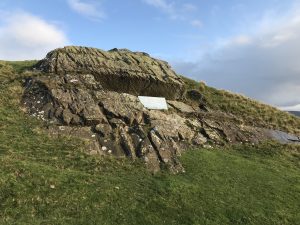
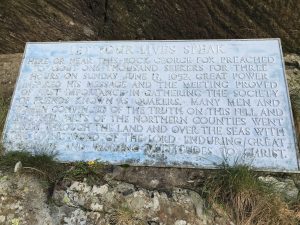 He famously preached to around 1000 ‘seekers’ for 3 hours at the place known as ‘Fox’s Pulpit’ (Grid reference SD 619937) on Firbank fell above Sebergh .
He famously preached to around 1000 ‘seekers’ for 3 hours at the place known as ‘Fox’s Pulpit’ (Grid reference SD 619937) on Firbank fell above Sebergh .
They believed in divine guidance that they called the ‘inner light’. They objected to paying tithes and the church rate and consequently found themselves in conflict with the authorities. They rejected the rule of the bishops and liturgies set by law. Meetings were held in private houses and did at times result in the householders being fined £20 and individual participants being fined 5 or 10 shillings each. They became a people set apart because of their puritanical strict disciplines.
Richard Robinson of Countersett Hall is considered to be the first Quaker in Wensleydale. His religious curiosity found no answer in the established church, and he was drawn to Thomas Taylor, a dissenting minister in Carleton in Craven who was leading a group of separatist ‘Seekers’ at Preston Park in southern Lakeland. Together they went to meetings to hear George Fox’s preaching at Grayrigg and Hutton. He later declared that George Fox’s preaching ‘opened the way to true salvation’
He became an itinerant preacher throughout the north of England and was imprisoned several times. In 1672 whilst in Richmond prison he wrote about the appalling suffering of Quakers around the northern Dales.
Quakers initially met at both Countersett Hall and Carr End in Raydale. Carr end was the home of the Fothergill family and they were significant in the movement around the country and around the world. Alexander Fotthergill was a surveyor who was responsible for overseeing the Richmond – Lancaster Turnpike road and building many bridges in the dales including the one at the outlet of Semerwater. Samuel Fothergill was a noted preacher and John Fothergill was one of the most sought after physicians in 18th century London. He was an important figure amongst the London Quakers and established Ackworth school in Pontefract in 1779.
The Hillary family living at Rigg House near the entrance to Cotterdale were initially prominent Quakers at the Hawes meeting. John Hillary married Mary Robinson at Semerdale House in 1692. They later moved to Hillary House in Burtersett and joined the Countersett meeting. Their son William became a prominent Doctor and a specialist in Topical Diseases. His influence stretched to Barbados and he was involved with the early Friends in America. William’s nephew (another William) was responsible for the establishment of the RNLI in 1824. Sir William Hillary was married in 1800 and departed from his Quaker beliefs. He was responsible for selling the properties in Wensleydale.
The Conventicle Act 1664 and Five Mile Act 1665 were passed to restrict activities of groups like the Quakers. These acts of parliament were designed to prevent religious assemblies of more than 5 people meeting outside the auspices of the Church of England and to prevent a minister expelled from the church living and working within 5 miles of the place he used to preside over, unless he swore again to obey the 1662 prayer book. During the reign of William and Mary, the Act of toleration was passed in 1689 which gave the right to worship and build meeting houses. It also required a registration of meetings.
At this time meetings were registered at Bainbridge, Hawes, Carperby, West Burton and Leyburn
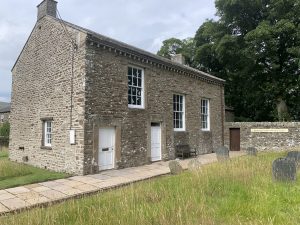 In Bainbridge a cottage that had been bought earlier was now freely used from 1689 onwards. The present meeting House was built in 1836 and is still being used today.
In Bainbridge a cottage that had been bought earlier was now freely used from 1689 onwards. The present meeting House was built in 1836 and is still being used today.
In Hawes and Appersett early meetings took place in the Routh’s home. (Oswald Routh left land for a burial ground in Hawes at Town Foot, opposite the playground) By early 1700 a cottage was purchased for a meeting house in Hawes and continued to be used until 1920. In 1955 the property was demolished for road widening.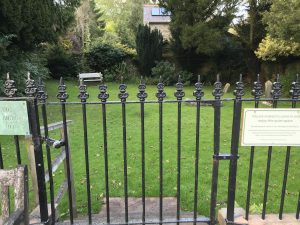 The graveyard remains, but is unused though it is open as a ‘quiet space’ for people to use. Thomas Fawcett, a quaker in Hawes, is reputed to have built a cottage in 1668 – now a restaurant with an inscription above door which reads ‘God being with us – who can be against us’ – words taken from Romans chapter 8.
The graveyard remains, but is unused though it is open as a ‘quiet space’ for people to use. Thomas Fawcett, a quaker in Hawes, is reputed to have built a cottage in 1668 – now a restaurant with an inscription above door which reads ‘God being with us – who can be against us’ – words taken from Romans chapter 8.
In Appersett a property on left as you enter from Hawes was possibly a meeting house with its burial ground on the corner opposite. (It was a custom for every meeting house to have a graveyard). This may have been used by Sandemanians as some of the Willans family in Appersett were Sandemanian and they were buried in Gayle. The cottage was later used by the Methodists
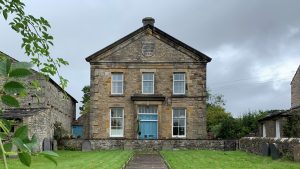 Quakers met in Leyburn as early as 1653 (the Coverdale meeting), originally meeting in homes (Richard Geldart used his home. He was convinced by Quakerism after hearing Richard Robinson preach at Countersett). Meetings ceased by 1738, however by 1796 Friends from Richmond began meeting in Leyburn again. This also was short lived and the meeting was closed again in 1821 as Friends joined the Aysgarth meeting. (established in 1704). In the early 19th century the Aysgarth and Carperby meetings combined and a meeting house was built in Carperby in 1864. This meeting house closed in 1984 and Friends from here started meeting in Leyburn again establishing a meeting house for the lower dale and Swaledale at 7 Grove Square.
Quakers met in Leyburn as early as 1653 (the Coverdale meeting), originally meeting in homes (Richard Geldart used his home. He was convinced by Quakerism after hearing Richard Robinson preach at Countersett). Meetings ceased by 1738, however by 1796 Friends from Richmond began meeting in Leyburn again. This also was short lived and the meeting was closed again in 1821 as Friends joined the Aysgarth meeting. (established in 1704). In the early 19th century the Aysgarth and Carperby meetings combined and a meeting house was built in Carperby in 1864. This meeting house closed in 1984 and Friends from here started meeting in Leyburn again establishing a meeting house for the lower dale and Swaledale at 7 Grove Square.
Other Meeting Houses had been established at Chantry (West Witton) (1720) and Carleton in Coverdale (1743).
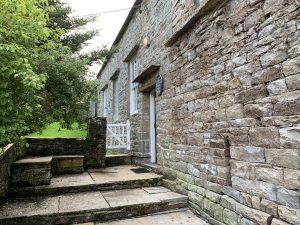 The meeting house in Countersett was opened in 1710, twenty years after Richard Robinson’s death. There had by this time been almost 60 years of quakers meeting in Raydale – at Countersett Hall and at Carr End, the home of the Fothergill Family.
The meeting house in Countersett was opened in 1710, twenty years after Richard Robinson’s death. There had by this time been almost 60 years of quakers meeting in Raydale – at Countersett Hall and at Carr End, the home of the Fothergill Family.
The Quakers grew in numbers during 18th Century but declined into the 19th as a result of growth of other non-conformists and significant emigration to America. Some found the strict discipline and some of the marriage rules hard – you could only marry within the sect.
The Ingamites and the Sandemanians
Benjamin Ingham was born in 1712 at Town End in Ossett. He attended Batley Grammar School and matriculated to Queens College, Oxford. He was a contemporary of John and Charles Wesley and with them was part of the ‘Holy Club’. He was ordained into the Church of England in 1735 and in the same year traveled to Georgia in America with the Wesleys on a preaching mission. The journey there was eventful in many ways. The sailing in ‘The Simmonds’ was rough with many storms, some quite ferocious. Many of the 80 plus English passengers feared for there lives. However, there was a calmness among a group of 26 Moravians from Hernhuth in Germany. Their focus in prayer through those storms impressed Ingham.
The mission in America was not successful and Benjamin Ingham planned to return home to recruit more missioners. A month before he set sail for England, he attended a Moravian meeting and there he ‘found rest for his soul in a profound evangelical conversion experience’
In late 1737 he returned to England and north to Ossett. He began an itinerant preaching ministry having been banned from preaching in Wakefield Cathedral and other churches in the diocese of York. His Preaching throughout Yorkshire and the north saw many converts and initially over 60 Ingamite Societies. He handed these over to the Moravians at first for them to manage. William Batty, one of his local preachers from Gayle records that,
‘whilst Ingham was instrumental in bringing the Moravians to Yorkshire, he declared himself neither a Methodist nor a Moravian.’
Benjamin Ingham had some ‘uneasiness with the Moravian ‘Stillness Doctrine’ which taught that those who lacked the full assurance of salvation should engage in no spiritual activities. In other words, Bible reading, prayer and attendance at the Lord’s Supper were to be forsaken until such assurance came. The Moravians also taught that assurance was the essence of true faith, and that the existence of doubts and fears was a sign of the absence of such faith. Ingham had spoken against these perceived errors publicly.’ (Pastor Kevin Price 2016)
In 1741 he also broke his connection with the Wesley’s because of their ‘Holiness’ or ‘Entire Sanctification’ doctrine. As a result, many of Inghams supporters refused to attend Methodist meetings when John Wesley visited the north.
The 1750’s where the best years for the Ingahamite denomination with chapels being developed across the whole of the north of England, especially in the Yorkshire Dales, the Forest of Bowland. Colne, Barnoldswick, Kendal, …………. and West Yorkshire. The chapels were disciplined societies with strict membership rules which is understandable as they were seeking to maintain a purity of the gospel.
A small Ingamite chapel existed at Ravenseat farm in Upper Swaledale. Ella Pontefract and Marie Hartley describe that, at that time there were two farms, eleven families with the men working at Tan Hill Pits. When what became a barn was knocked down there was still a pulpit in the corner.
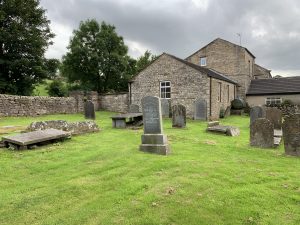 Two prominent Inghamite preachers William Battey and James Allen built an Inghamite chapel in Gayle during the 1750’s with a Sunday School later being established in Dyers Garth, in Hawes.
Two prominent Inghamite preachers William Battey and James Allen built an Inghamite chapel in Gayle during the 1750’s with a Sunday School later being established in Dyers Garth, in Hawes.
What has been described as one of Ingham’s greatest mistakes occurred when he read some of John Glas’ writing and sent James Allen and William Batty to Glasgow in 1761 to find out more.
John Glas was a Presbyterian Minister in Glasgow and he was unhappy with the national church whose organization, he claimed, found no support in the new testament. He established his own church and they were called ‘the Glasites’. His son in law Robert Sandeman became a leader in the church and brought the church to London and America. The Sandemanians where very strict in their observances and quite exclusive. Their first developments outside London occurred in Yorkshire. James Allen and Willian Batty were so impressed with what they saw and returned to Gayle and converted the Inghamite chapel into a Sandemanian chapel as well developing chapels in Kirby Stephen, Newby and Kirkby Lonsdale. By 1768 James Allen had helped establish church congregations in York, Norfolk and Colne.
In Gayle, two services were held each Sunday with the Lord’s Supper being administrated to the faithful in the morning and a Gospel service in the afternoon. In between they had a common meal at the Old Hall, the home of the Allen family. Services ceased towards the end of the 19th Century and in 1929 the chapel became the village institute. The graveyard is next to it.
Benjamin Ingham was not convinced. As well as the debate on church government, there was also a doctrinal issue. The Sandemanians believed that mental assent to the doctrines of the Gospel was sufficient to possess saving faith; a person need only claim that he was willing to be led by the Scripture. The place of conviction of sin was therefore not found.
Ingham never accepted the Sandemanian theology and the split with James Allen was never resolved.
For a fuller account of Benjamin Ingham’s life and witness in the Dales and his links with John Wesley and James Allen, as well as the Moravian Church, visit the Website of Salem Congregational Church, Martin Top. https://www.martintop.org.uk/content/benjamin-ingham
See also: ‘Fine Gold from Yorkshire’ Chapter 9 Benjamin Ingham (Author: Faith Cook EP Books)
The Congregationalists
Robert Brown (1550 -1633) was living during the reign of Elizabeth I and he became a separatist partly by listening to neo Calvinist talks and cross fertilization with the Anabaptists. He openly criticized the church’s administration and leadership. He was jailed many times but always soon released because of his wealthy contacts and contacts in the government. He set up the first separatist church in Norwich and some early members of his congregation were arrested tried and hanged at Bury St Edmunds for selling some of his ‘seditious’ writings. Robert Browne is considered the father of Congregationalism. He is also seen by some as the father of the Pilgrims as the Mayflower passengers in 1620 included members of the Brownist movement.
As a group of protestants separatists, the Congregationalists advocated separation from the Church of England rather than reform. Their church structure emphasised the right and responsibility of each congregation to manage its own affairs. The 1658 the Savoy Declaration (formulated in the Savoy Hotel) was the Congregationalist ‘confession of faith’.
Separatists experienced mixed fortunes in the early years,
suffering persecution during the reign of Elizabeth I
receiving greater support with Oliver Cromwell
increasingly difficult times following the Act of Uniformity of 1662 (Charles I), the Conventicle Act of 1664 and the Five Mile Act of 1665
support at the time of the Toleration Act of 1689 during the reign of William and Mary
problems during the reign of Queen Anne when the Schism Act in 1714 threatened the survival of the Congregational Schools (as well as Catholic Schools)
a final period of stability when George I came to the throne (1714)
at the start of the 18th century the rise of Methodism and later the Evangelical Revival (1750 – 1815) had a significant impact on Congregationalism. George Whitfield had close relationships with the Congregationalists.
Lord Wharton the 4th Baron (1613 -1696), whose family had residences at Aske Hall near Richmond, Wharton Hall, at Nateby near Kirkby Stephen, and at Healaugh Priory, Tadcaster, was significant in the growth of some chapels in the Dales. He was sympathetic to the dissenters from the Church of England and gave money to support the establishment of chapels at Ravenstonedale and Smarber near Low Row in Swaledale, Rent from 2 parcels of land near Nateby provided salaries for the ministers.
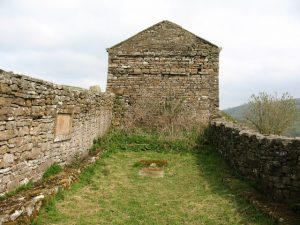 Smarber chapel was built in 1691 on the hillside just west of Low Row. It was part of Smarber Hall – Lord Wharton’s shooting lodge. It is registered at Thirsk as a ‘Meeting House adjoining Smarber Hall for Protestant Dissenters’. (Grid Ref: SD9728097565) It was establish beyond the 5 mile limit of Grinton Church. (Presumably the churches at Muker and possibly Keld were Chapels of Ease). The first minister in 1693 was Rev John Holland. Smarber closed in 1809 when the chapel at Low Row was built. The present building replaced in 1874 is now a United Reformed church. Meetings are held annually at the old chapel (photo: Gordon Hatton) in August to maintain the endowment established by Lord Wharton
Smarber chapel was built in 1691 on the hillside just west of Low Row. It was part of Smarber Hall – Lord Wharton’s shooting lodge. It is registered at Thirsk as a ‘Meeting House adjoining Smarber Hall for Protestant Dissenters’. (Grid Ref: SD9728097565) It was establish beyond the 5 mile limit of Grinton Church. (Presumably the churches at Muker and possibly Keld were Chapels of Ease). The first minister in 1693 was Rev John Holland. Smarber closed in 1809 when the chapel at Low Row was built. The present building replaced in 1874 is now a United Reformed church. Meetings are held annually at the old chapel (photo: Gordon Hatton) in August to maintain the endowment established by Lord Wharton
Shortly before he died in 1696, Lord Wharton instructed that some money in his will continued to be used for a practice he had set up in his latter years – to give bibles to young people. This trust still operates and details can be found at: Wharton Bibles
Chapels in the Dales
As well as the early Congregational chapels built in Ravenstonedale (1662) and Low Row (1691) at a time when persecution was rife, 18th Century chapels were built at Reeth (1783), Keld (1789) and Leyburn (1793). 19th century chapels were built in Dent, Sedbergh, Thwaite, Hawes (1851), Burtersett (1876), Bainbridge (1865) and West Burton. There was a shared chapel built in Widdale (1863).
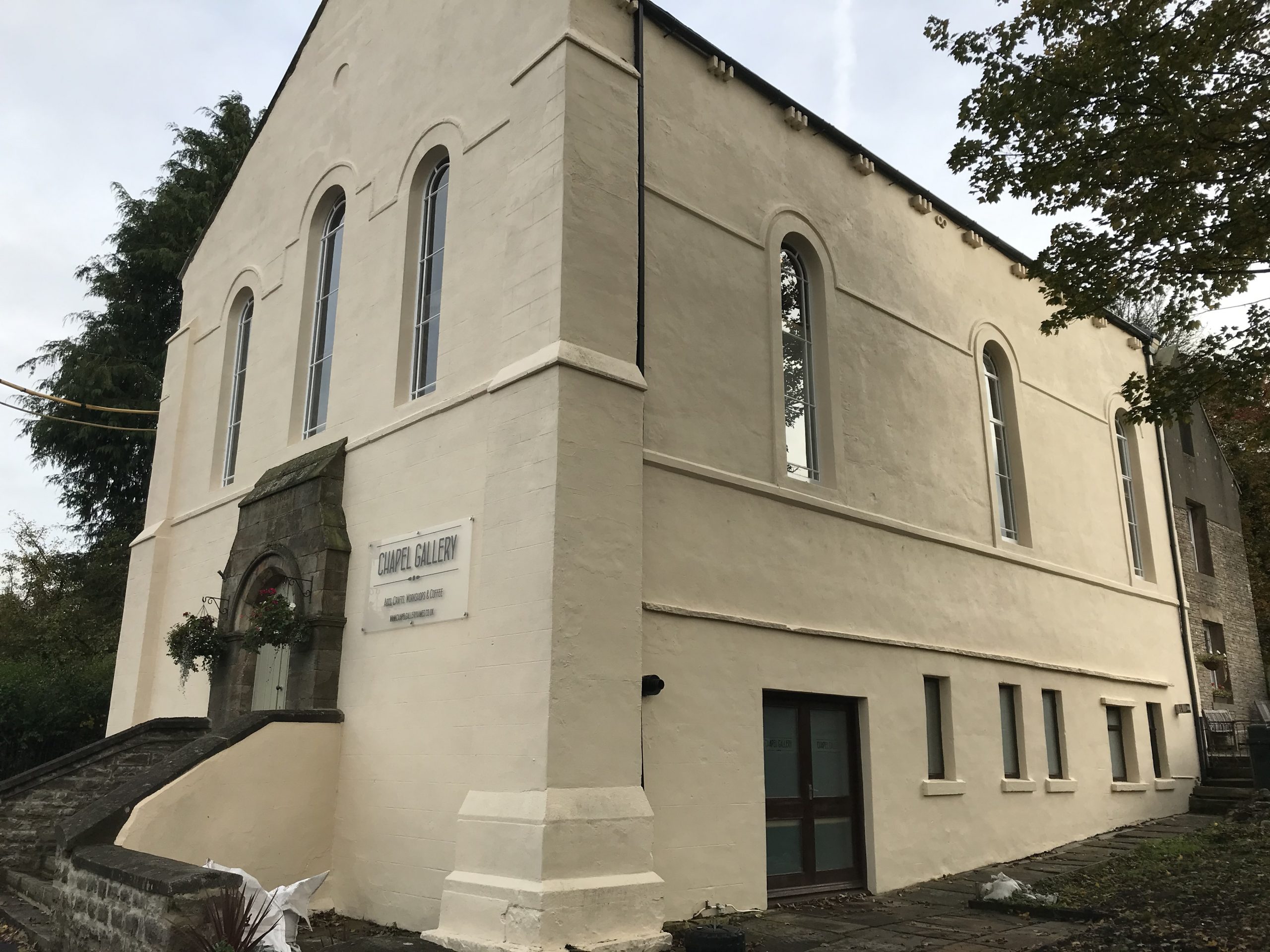
Hawes Congregationalists began in 1843 with Rev W Palmer becoming the first Minister and he was succeeded by Rev J W Rolls in 1846. They took over Dyers Garth Sunday School from the Sandemanians and during these early years numbers grew rapidly from 11 to 76 so that by 1849 they decided to buy land to build their chapel. The chapel was completed in 1851 . It was known as Bethel meaning ‘House of God’ and became the centre of Evangelistic activity with services being held in many surrounding villages. The centenary celebrations were held in 1943. The Bethel Church in Hawes became part of the United reform Church when the Congregation Churches in Britain merged with the Presbyterian church in 1972. The chapel is now closed and has been used as a Gallery for some time.
Baptists
The Baptists developed out of 17th Century puritanism and trace their roots to the Anabaptist movement (Mennonite) in Amsterdam. Their theology was Calvanistic and the church structure was akin to the Congregationalists. Particular Baptists (as opposed to General Baptists) were non separatist in that they didn’t totally deny the position of the established Church of England, though felt the need to be independents.
There is little evidence of a Baptist Church in the Dale beyond Snape near the entrance to Wensleydale. In developing their churches, the Baptists bypassed the dales and developed their congregations in the Northallerton gap and northwards into county Durham.
However there are two references to Baptists in the dale:
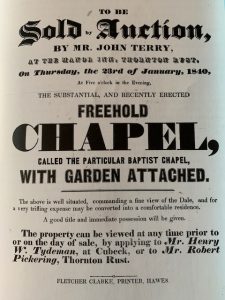
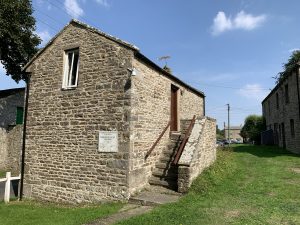
A Calvanist chapel in Thorton Rust was founded 1827 with a school room below. John Tomlinson gave money to support minister and schoolmaster. One woman in the village disagreed with some of the Calvanist ideas and established a Baptist church at the west end of the village. An inscription above the door read ‘Jehovah my Banner Particular Baptist 1836’ The chapel didn’t last long and was later sold. It is now West View farm.(A barn behind the house was used as Wesleyan chapel)
The Calvanistic chapel is now the mission room – part of St Andrew’s Benefice.
In 1840’s Robert Capstick of Burtersett was described as a Baptist minister. He ran the shop and probably held services in his home. They were known as Particular Baptists and conducted baptisms by total immersion in the river Ure.
Methodism
John Wesley was born in 1703 – the 15th child of Samuel Wesley an Anglican Minister at Epworth in Lincolnshire. John himself became an Anglican priest in 1728. Ten years later, he and his brother Charles had what they described as a ‘spiritual awakening’ at a Moravian meeting in Aldersgate, London on 24th May 1738. He described this evangelical conversion as ‘his heart being strangely warmed’ and he gained an assurance of his salvation. With the encouragement of George Whitfield, he began his ministry as a travelling evangelist, mainly preaching outdoors. He never intended to establish a separate church. Early followers were expected to go to parish church for communion, but later, societies were formed with afternoon and evening meetings arranged. Eventually, Wesley ordained his own ministers and began to build chapels. By 1791 when Wesley died – separation was complete and the Methodist church had been established.
John Wesley visited Wensleydale in 1743 and 1774 and preached at Wensley, Redmire and Castle Bolton. In 1765 a minister was appointed in Middleham and by the end of the century a circuit was established in the Middleham area extending west as far as Bainbridge.
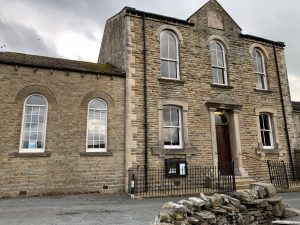 Methodism came to the upper dale from Kendal and Sedbergh (Wesley had visited Kendal several times) and an early society was formed in Garsdale. Between 1825 – 35 Garsdale miners came to Gayle to work at Storth pits in Sledale and the Methodists among them began meetings. The chapel in Gayle was built in 1833 and was part of the Kendal circuit. When a Sunday School was built in 1855 it is recorded that there were 16 teachers and 50 scholars with 54 church members. In 1879 the chapel was extended with a new front and gallery. Gayle chapel was noted for evangelistic missions, their band of hope, class meetings and open air meetings.
Methodism came to the upper dale from Kendal and Sedbergh (Wesley had visited Kendal several times) and an early society was formed in Garsdale. Between 1825 – 35 Garsdale miners came to Gayle to work at Storth pits in Sledale and the Methodists among them began meetings. The chapel in Gayle was built in 1833 and was part of the Kendal circuit. When a Sunday School was built in 1855 it is recorded that there were 16 teachers and 50 scholars with 54 church members. In 1879 the chapel was extended with a new front and gallery. Gayle chapel was noted for evangelistic missions, their band of hope, class meetings and open air meetings.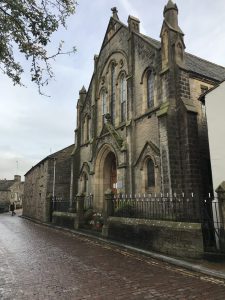
Hawes chapel was built on land given by William Whaley in 1856. It had a similar plan to the ‘Bethel’ Congregational church. Problems with damp in the lower ground area resulted in it being demolished and rebuilt in 1913. The first organ installed was a memorial to the first world war.
In 1871 Hawes became an independent circuit and included Bainbridge, Askrigg and Marsett. It later amalgamated with Middleham and Leyburn in 1901 becoming the Wensleydale Circuit with 3 ministers. Cottage meetings were taking place at Birkrigg, Lunds, Worton and Appersett (in the Quaker meeting house). Burtersett chapel had been built in 1874 and was enlarged in 1904 as the local quarries expanded. The Methodists were worshiping in Widdale for some time during the last century using the congregational chapel. Having stood empty for a long time, this is now being converted into housing.
For some of the above notes on Methodism – Acknowledgements to James Alderson ‘Under Wetherfell’
Primitive Methodists
In 1810 revival meetings at Mow Cop in Staffordshire resulted in the establishment of the Primitive Methodists who in part were attempting to get back to the simplicity of the early Methodists and maintain the evangelistic traditions and focus.
Hugh Bourne and William Clowes were prominent leaders in this movement. The ‘prims’ attracted working class adherents with their simple, plain design of their chapels and their direct, spontaneous and passionate worship. They were often called ‘Ranters’ due to their more charismatic style. They were keen temperance advocates and involved in many social reform programmes.
Primitive Methodists created their own circuits and built chapels. In 1822 a Middleham circuit was established with 12 Sunday Schools and 20 meetings in cottages. The first chapel was built in Cotterdale by 1836. By 1870 a Primitive Methodist Society existed in Hawes and chapels were built in Askrigg – Moor road (1869), Sedbusk (1875), Bowbridge and the ‘Prims’ were using the Quaker meeting house at Countersett. And chapels opened in Dent (1840), Garsdale Street (1841) and Deepdale (1889)
Cotterdale Revival
In the early 1830’s, Cotterdale was known as a ‘rough’ place. Lord Wharncliffe who owned the estate had to emloy four gamekeepers to keep the poaching down. A Primitive Methodist preacher – possibly William Clowes from Burslem, travelling to or from Kendal felt he should go into the dale but was warned not to. He went in regardless and conducted an outdoor service. A number were converted – the beginning of the revival. Following this local men built the chapel on land given by Lord Wharncliffe who also subsequently only employed one gamekeeper because of the ‘change of heart’ of the local people.
[Related by Bill Phatt from Kendal – a local preacher himself who had relatives living in Cotterdale]
The chapel opened in 1836 and at one point had 40 members.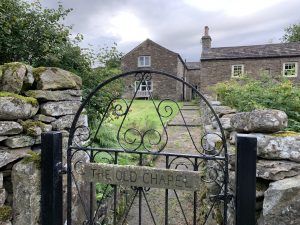
The record of Ralph Metcalf (1804 – 1838) whose family moved from Lunds to farm in Cotterdale
Ralph became regular in his attendance upon the Primitive Methodist’s means of grace; but continued a stranger to saving religion until the beginning of the year 1836, when, by the goodness of the Lord, a blessed revival of religion broke out, and affected nearly the whole of the inhabitants in the dale.
The work first appeared at a class-meeting held in my father’s house, when my brother William was suddenly and unexpectedly brought into gospel liberty. And from that time it began inwardly to work like fire in the bowels of proper materials.
And in about three weeks the Lord broke in upon the assembled congregation.
That divine influence which had been working inwardly burst into a visible flame.
The greater part of the congregation were arrested by the power of conviction, and a cry for mercy followed; and it seemed as if the answer to so many faithful prayers could no longer be delayed.
The following Thursday Brother North, the superintendent preacher, on some account not coming to his appointment I had to supply for him.
And that night several penitents found liberty; and the good work proceeded till our seven members were increased to upwards of forty; most of whom were made happy in the prayer meetings, which were then held every night; and which sometimes did not break up till morning.
Our praying company being greatly enlarged, and filled with love to God and man, could not contain themselves within their own place, but went forth into a neighbourhood called Mossdale, where the work broke out, and a society of eight or nine members was raised.
Memoir of Ralph Metcalf – My Primitive Methodists
It is interesting to note that Cotterdale was a haven for 6 Catholic families who were avoiding persecution during the reign of Elizabeth I
Bowbridge revival (Low Abbotside Primitive Methodist Chapel)
In 1918 Rev Dr Scurrah spoke of his memories from 50 years previously in 1868 when the chapel had over 100 members following an 8 week mission led by William Handley.
‘He, with others, had formed a mission band, and walked miles to proclaim Christ. They were eager to promote the work of God, and realised great success.’
For years following, The Bowbridge Society continued to be under the influence of that gracious revival.
The present building built was built 1908 and closed closed in 1962. It is now a private house.
Hawes Junction (Originally – Mount Zion)
The original location of the church was in house next to Moorcock. There were a large number of locals living in a ‘shanty town’ for the railway construction. Local Methodists were significant providers of welfare for railway workers. The railway opened in May 1876 and the Midland railway company built the present Chapel. Reuban Alton – converted at Bainbridge revival – laid foundation stone 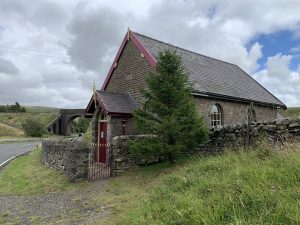 for the chapel. There were 15 – 20 members originally and the chapel was part of the Middleham circuit and then later from 1885, the Dent circuit.
for the chapel. There were 15 – 20 members originally and the chapel was part of the Middleham circuit and then later from 1885, the Dent circuit.
A significant preacher and evangelist at this time was Dick Atkinson – a local gamekeeper living in Grisedale. He died aged 40 in 1880. The Wesleyan Chapel in Grisedale was built 1889 in memory
A revival at Hawes Junction in 1882 saw the chapel with 60 members (35 new members).
The Methodist Union of 1932 saw the Wesleyan and Primitive circuits joined, though in some parts of the country, including East Yorkshire, a small number of Primitive Methodists ‘continued’ in their own right.
Some of the history of the Primitive Methodist (Continuing) Church can viewed HERE. The writer of this page grew up attending Redbourne Street Primitive Methodist Church in Hull referred to in this article.
Key Dates
12th C Aysgarth and Askrigg churches built
1145 Jervaulx abbey established first at Fors, Bowbridge near Askrigg. 10 years later moved to present site near East Witton
1202 Knights Templars build preceptory south of Temple Farm (Penhill)
1483 First priest appointed in Hawes (Roman Catholic)
1517 Luther posts 95 Thesis on church door in Wittenberg – ‘start’ of the protestant reformation
1534 Henry VIII ‘established’ Church of England and started the dissolution of the monasteries
1620 Probable existence of original ‘chapel’ in Hawes (on site of present Parish Church)
1652 George Fox (Quakers) preached near Sedbergh
1658 Savoy declaration (Congregationalism)
1662 ‘final revision’ of Church of England Prayer Book
Congregational church built in Ravenstonedale
1689 Toleration Act passed in parliament giving freedom of worship (to independants)
Quakers meeting ‘freely’ in Bainbridge
1691 Smarber congregational chapel built in Swaledale
18th C Early Congregational churches built in the dales
1735 Benjamin Ingham travels to America with the Wesleys – first encounter with the Moravians
1738 Methodist movement begins – John Wesley at Aldersgate
1750’s Inghamite Chapel built in Gayle (became Sandemanian Chapel shortly afterwards)
Evangelical revival (1750 – 1815)
1765 Methodist minister appointed in Middleham
1810 Primitive Methodists meet on Mow Cop Staffordshire
1833 Gayle Methodist Chapel Built
1836 Primitive Methodist Chapel built in Cotterdale
Baptist Chapel in Thornton Rust
1851 Hawes Congregational chapel built (Bethel)
Hawes New Parish Church built (St Margaret’s) – within one year
1856 Hawes Methodist Chapel Built (rebuilt 1913)
1874 Primitive Methodist Chapel built in Sedbusk
1932 Methodist Union – Wesleyan and Primitive Methodists United
1972 United Reform Church formed between the Congregationalists and Presbyterians
Early Faith in the Dales – Mike Hirst
; ?>/images/cross.png)

